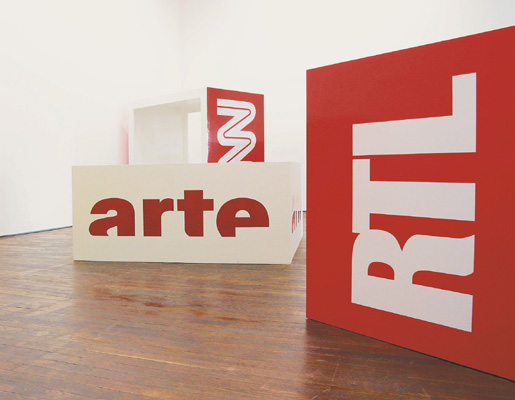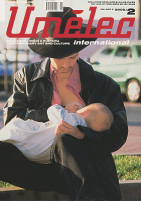| Umělec magazine 2002/2 >> Terrorists in a Slovak Living Room | List of all editions. | ||||||||||||
|
|||||||||||||
Terrorists in a Slovak Living RoomUmělec magazine 2002/201.02.2002 Linda Osyková | reviews | en cs |
|||||||||||||
|
"Re:Location 1: Juraj Dudáš, Jerry Frantz, Dany Prum,
Casino Luxembourg — Forum d’art contemporain, Luxembourg, 9 March–9 June 2002, Galéria Jána Koniarka, Trnava CZ, 29 June–31 Aug. 2002 The opening of Re:Location 1 on 8 March, 2002 in Luxembourg launched an extensive art project by the European centers for contemporary art, which initiated the international network Art Centers of Europe (ACE). A number of European art institutes have joined the project, including Bunkier Sztuki—Galerie Sztuki Współczesnej in Cracow, Poland; Centrul Cultural Sindan in Cluj, Romania; O.K. Centrum für Gegen-wartskunst in Linz, Austria; Villa Arson—Centre National des Arts Plastique in Nice, France; Migros Museum—Museum für Gegenwartskunst in Zürich, Switzerland; and Künstlerbund in Berlin. The project will end in the summer of 2004 with a simultaneous exhibition of contemporary art titled Re:Location Shake all participating galleries. For the first round of Re:Location, the Luxembourg curator and art director of Casino Luxembourg Enrico Lunghi chose to put on a show by young Slovak artist, Juraj Dudáš. In return Viera Jančeková, curator of Ján Koniarek Gallery, chose the Luxembourg artists Jerry Frantz and Dany Prum. Jerry Frantz lived for a month in Slovakia and Juraj Dudáš went to Luxembourg while Dany Prum communicated with both artists over the Internet. The birth of a baby girl, Lisie, to the friends of the Luxembourg artists strongly influenced the character of their common project, with Jerry Frantz deciding to make Lisie his medium for getting to know Slovakia. He traveled there with a doll that substituted for the actual baby. The extremes in Slovak reality both fascinated him and provided him with a source of inspiration. The artist experienced everyday Slovak life, images of the country’s post-communist past, complete with the relics of dark industrial quarters and neglected historical monuments. For the presentation of Lisie’s experiences the two artists recreated a typical Slovak living room in the gallery space, which — like the rest of the country — blended various ambivalent aspects (tacky furniture from the Communist era when there was a dearth of material, and quality “capitalist” computer equipment). Visitors can ensconce themselves in sofas, page through an album full of photographs (the most powerful ones were pasted onto the typical “stylish” wallpaper) and check out the short video showing Lisie’s stories in Slovakia. In the second part of the exhibition, Juraj Dudáš presented logos used on the microphones of TV channels that were blown up to huge dimensions. Choosing channels that were appropriate for the first phase of the project, RTL from Luxembourg and Slovak Public Television (STV), he added international mass media superstars, including CNN and its potential competitors Al-Jazeera (intentionally exhibited side by side), BBC, and ARTE. By choosing the microphone logos — a typical aspect of TV news esthetics — Dudáš mocked the schematics of the media industry. He employed the same process used by media gurus but with opposite subtext. His message doesn’t make any sense and thus unmasks the essence of mass media. He aptly perceives the mass media through a selective lens; they are determined by a selective process and destroyed by it at the same time. Viewers themselves can test to what degree they are able to resist television camouflage and how much their consciousness and unconsciousness can be taken advantage of. Juraj Dudáš points out that people are willing to accept both the open and concealed manipulation conducted by television. His point of departure includes the principle that truth is a generally recognized value, and therefore is free for any spin-doctor to interpret it in a required manner and use it for the fabrication of a final product. Dudáš manages to visualize the complicated process of influencing public opinion through the means of true, semi-true and made up information passed off as truth. At the same time Dudáš is attracted to the media and enjoys it like any media recipient. The news program intros fascinate him; so he packed them into a tight sequence and made one visually compelling intro from CNN-BBC-RTL-ORF-STV-Markíza-ČT-Nova-MTV. Dudáš also created some short video sequences for the exhibition. At first sight there’s nothing intellectual about his animation, entitled Intellectual Melodrama. The artist tells a banal story using primitive animation. The animation’s protagonists include DJ Giorgio, VJ Lin, a dog, and a swan (the latter not playing a big role). However absurd a story this might be, it is based on the real experiences of DJ Giorgio, alias Juraj Dudáš, although it is difficult to ascribe the experiences to either Giorgio or Dudáš because their lives often dissolve into one another The animation Illegal Art shows the main character, once again DJ Giorgio, in a, once again, outwardly absurd story. With help from the art-terrorist Killer Jerry and Killer Dany, alias Jerry Franz and Dany Prum, DJ Giorgio smuggles illegal art across the border into the EU. Referring to the previously mentioned selection process of media, the story also includes encoded political and social issues of regional European contexts (labor issues of the Slovak truck drivers in Luxembourg), but also an international character (accession negotiations and conditions for entry into the European Union, the war against terrorism, the situation in Afghanistan). DJ/J.D. is a smuggler of spiritual values: “katholic art,” heavy metal, hard core, soft porn, intellectual melodrama, Lisie... "
01.02.2002
Recommended articles
|
|||||||||||||








Comments
There are currently no comments.Add new comment